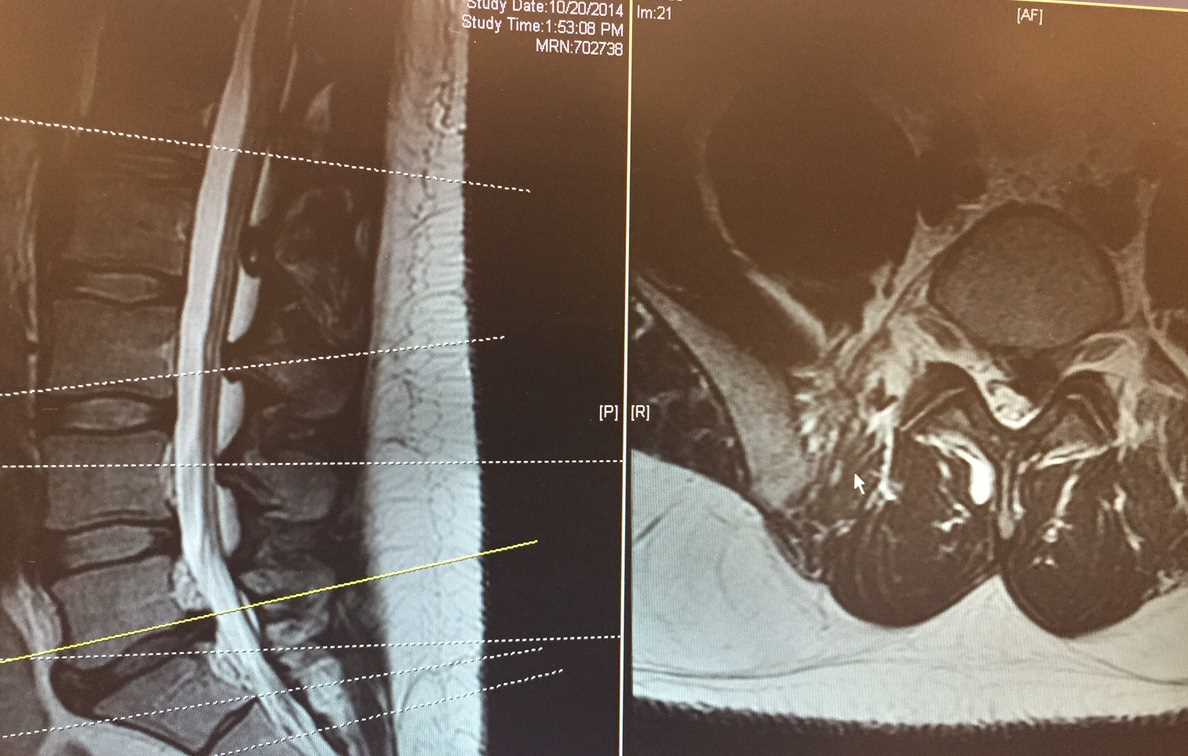[1]
Tang C, Moser FG, Reveille J, Bruckel J, Weisman MH. Cauda Equina Syndrome in Ankylosing Spondylitis: Challenges in Diagnosis, Management, and Pathogenesis. The Journal of rheumatology. 2019 Dec:46(12):1582-1588. doi: 10.3899/jrheum.181259. Epub 2019 Apr 1
[PubMed PMID: 30936280]
[2]
Glassman DM, Magnusson E, Agel J, Bellabarba C, Bransford RJ. The impact of stenosis and translation on spinal cord injuries in traumatic cervical facet dislocations. The spine journal : official journal of the North American Spine Society. 2019 Apr:19(4):687-694. doi: 10.1016/j.spinee.2018.10.015. Epub 2018 Oct 25
[PubMed PMID: 30914130]
[3]
Bindal S, Bindal SK, Bindal M, Bindal AK. Noninstrumented Lumbar Fusion with Bone Morphogenetic Proteins for Spinal Stenosis with Spondylolisthesis in the Elderly. World neurosurgery. 2019 Jun:126():e1427-e1435. doi: 10.1016/j.wneu.2019.02.251. Epub 2019 Mar 21
[PubMed PMID: 30904805]
[4]
Messiah S, Tharian AR, Candido KD, Knezevic NN. Neurogenic Claudication: a Review of Current Understanding and Treatment Options. Current pain and headache reports. 2019 Mar 19:23(5):32. doi: 10.1007/s11916-019-0769-x. Epub 2019 Mar 19
[PubMed PMID: 30888546]
Level 3 (low-level) evidence
[5]
Urits I, Burshtein A, Sharma M, Testa L, Gold PA, Orhurhu V, Viswanath O, Jones MR, Sidransky MA, Spektor B, Kaye AD. Low Back Pain, a Comprehensive Review: Pathophysiology, Diagnosis, and Treatment. Current pain and headache reports. 2019 Mar 11:23(3):23. doi: 10.1007/s11916-019-0757-1. Epub 2019 Mar 11
[PubMed PMID: 30854609]
[6]
Bagley C, MacAllister M, Dosselman L, Moreno J, Aoun SG, El Ahmadieh TY. Current concepts and recent advances in understanding and managing lumbar spine stenosis. F1000Research. 2019:8():. pii: F1000 Faculty Rev-137. doi: 10.12688/f1000research.16082.1. Epub 2019 Jan 31
[PubMed PMID: 30774933]
Level 3 (low-level) evidence
[7]
Melancia JL, Francisco AF, Antunes JL. Spinal stenosis. Handbook of clinical neurology. 2014:119():541-9. doi: 10.1016/B978-0-7020-4086-3.00035-7. Epub
[PubMed PMID: 24365318]
[8]
Akar E, Somay H. Comparative morphometric analysis of congenital and acquired lumbar spinal stenosis. Journal of clinical neuroscience : official journal of the Neurosurgical Society of Australasia. 2019 Oct:68():256-261. doi: 10.1016/j.jocn.2019.07.015. Epub 2019 Jul 19
[PubMed PMID: 31331753]
Level 2 (mid-level) evidence
[9]
Schroeder GD, Kurd MF, Vaccaro AR. Lumbar Spinal Stenosis: How Is It Classified? The Journal of the American Academy of Orthopaedic Surgeons. 2016 Dec:24(12):843-852
[PubMed PMID: 27849674]
[10]
Shim DM, Kim TG, Koo JS, Kwon YH, Kim CS. Is It Radiculopathy or Referred Pain? Buttock Pain in Spinal Stenosis Patients. Clinics in orthopedic surgery. 2019 Mar:11(1):89-94. doi: 10.4055/cios.2019.11.1.89. Epub 2019 Feb 18
[PubMed PMID: 30838112]
[11]
Stienen MN, Ho AL, Staartjes VE, Maldaner N, Veeravagu A, Desai A, Gautschi OP, Bellut D, Regli L, Ratliff JK, Park J. Objective measures of functional impairment for degenerative diseases of the lumbar spine: a systematic review of the literature. The spine journal : official journal of the North American Spine Society. 2019 Jul:19(7):1276-1293. doi: 10.1016/j.spinee.2019.02.014. Epub 2019 Mar 2
[PubMed PMID: 30831316]
Level 1 (high-level) evidence
[12]
Kaye AD, Manchikanti L, Novitch MB, Mungrue IN, Anwar M, Jones MR, Helander EM, Cornett EM, Eng MR, Grider JS, Harned ME, Benyamin RM, Swicegood JR, Simopoulos TT, Abdi S, Urman RD, Deer TR, Bakhit C, Sanapati M, Atluri S, Pasupuleti R, Soin A, Diwan S, Vallejo R, Candido KD, Knezevic NN, Beall D, Albers SL, Latchaw RE, Prabhakar H, Hirsch JA. Responsible, Safe, and Effective Use of Antithrombotics and Anticoagulants in Patients Undergoing Interventional Techniques: American Society of Interventional Pain Physicians (ASIPP) Guidelines. Pain physician. 2019 Jan:22(1S):S75-S128
[PubMed PMID: 30717501]
[13]
Lavi ES, Pal A, Bleicher D, Kang K, Sidani C. MR Imaging of the Spine: Urgent and Emergent Indications. Seminars in ultrasound, CT, and MR. 2018 Dec:39(6):551-569. doi: 10.1053/j.sult.2018.10.006. Epub 2018 Oct 19
[PubMed PMID: 30527521]
[14]
Deer TR, Grider JS, Pope JE, Falowski S, Lamer TJ, Calodney A, Provenzano DA, Sayed D, Lee E, Wahezi SE, Kim C, Hunter C, Gupta M, Benyamin R, Chopko B, Demesmin D, Diwan S, Gharibo C, Kapural L, Kloth D, Klagges BD, Harned M, Simopoulos T, McJunkin T, Carlson JD, Rosenquist RW, Lubenow TR, Mekhail N. The MIST Guidelines: The Lumbar Spinal Stenosis Consensus Group Guidelines for Minimally Invasive Spine Treatment. Pain practice : the official journal of World Institute of Pain. 2019 Mar:19(3):250-274. doi: 10.1111/papr.12744. Epub 2018 Dec 2
[PubMed PMID: 30369003]
Level 3 (low-level) evidence
[15]
Williamson E, Ward L, Vadher K, Dutton SJ, Parker B, Petrou S, Hutchinson CE, Gagen R, Arden NK, Barker K, Boniface G, Bruce J, Collins G, Fairbank J, Fitch J, French DP, Garrett A, Gandhi V, Griffiths F, Hansen Z, Mallen C, Morris A, Lamb SE. Better Outcomes for Older people with Spinal Trouble (BOOST) Trial: a randomised controlled trial of a combined physical and psychological intervention for older adults with neurogenic claudication, a protocol. BMJ open. 2018 Oct 18:8(10):e022205. doi: 10.1136/bmjopen-2018-022205. Epub 2018 Oct 18
[PubMed PMID: 30341124]
Level 1 (high-level) evidence
[16]
Zaina F, Tomkins-Lane C, Carragee E, Negrini S. Surgical Versus Nonsurgical Treatment for Lumbar Spinal Stenosis. Spine. 2016 Jul 15:41(14):E857-E868. doi: 10.1097/BRS.0000000000001635. Epub
[PubMed PMID: 27128388]
Level 3 (low-level) evidence
[17]
Koenders N, Rushton A, Verra ML, Willems PC, Hoogeboom TJ, Staal JB. Pain and disability after first-time spinal fusion for lumbar degenerative disorders: a systematic review and meta-analysis. European spine journal : official publication of the European Spine Society, the European Spinal Deformity Society, and the European Section of the Cervical Spine Research Society. 2019 Apr:28(4):696-709. doi: 10.1007/s00586-018-5680-3. Epub 2018 Jul 11
[PubMed PMID: 29995169]
Level 1 (high-level) evidence

